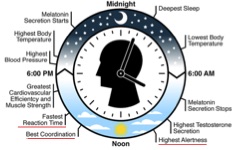The sleep process is tightly connected to the circadian rhythm, the 24-hour cycle of human physiological processes. Sleep is very important as it allows the body to recuperate and regen- erate cells. It is also tied to neurocognitive performance; the lack of or mistiming of sleep have been empirically linked to degeneration of neurocognitive performance and disruption of circa- dian rhythm regulation. There is ample literature on the mathematical models of the circadian rhythm dynamics and its interaction with light. There are also models that describe how the dynamics of sleep and neurobehavioral states are coupled to that of the circadian rhythm. The most popular variant, the two-process model, links the dynamics of sleep drive and alertness to the circadian phase. These models can provide quantitative predictions of these processes. The regulation of circadian rhythms is typically expressed as an optimal control problem of a system with nonlinear dynamics. The control inputs into the system are typically light (which is a strong circadian synchronizer) and chemicals such as melatonin. However, current mathematical results in the regulation of circadian rhythms do not take into account the interplay between the sleep process and the circadian process. This project aims to address the general problem where this interaction is central, and considers new optimization objectives such as alertness.
The goal of the project is to determine personalized optimal strategies for circadian rhythm regulation and scheduling of tasks and sleep to optimize mental perfor- mance of mission performers. Towards this goal, this project will focus on four directions of research:
1. Analyzing mathematical models that include both circadian and sleep processes for key properties, such as the stability of periodic solutions. Periodic solutions of such models correspond to stable entrainment of joint circadian-sleep-lighting processes.
2. Developing optimal algorithms for entrainment, such as entrainment in minimal time, for the combined circadian and sleep model.
3. Developing optimal strategies for maximizing mental alertness during critical missions. The subjects of the optimal strategies include scheduling of sleep, lighting, and tasks.
4. Developing state estimation algorithms that will allow for the implementation of the optimal strategies in the closed-loop, using biometric data from the mission performers. This will would also allow adaptation and personalization of the mathematical model during runtime.
Regulation of sleep and circadian rhythms has potential health impacts in individuals suffering from circadian disruptions, including, for example, long distance travelers, rotating shift workers, and workers in non-conventional day cycles (e.g. submariners). Further, these as- pects, in combination with mission scheduling, also impacts neurobehavioral performance (e.g. alertness) for critical tasks. Though solutions (including commercially available ones) have been proposed for circadian regulation and entrainment, for example for jetlag recovery. These solu- tions are typically based on models that do not take the sleep and alertness aspects in to account. They also use generic models that are based on population average, and provide an open loop solutions that do not allow for biometric feedback from the subject. This project will be based on comprehensive models of circadian, sleep, and alertness. The optimal control and scheduling solutions will be in a feedback form, allowing for biometric feedback from the users.
A Quantitative Approach to the Biochronicity of Circadian Rhythm, Sleep, and Neurobehavioral Performance
Army Research Office
John Wen
Agung Julius
Biomathematics: Personalized Optimal Regulation of Circadian Rhythms and Related Processes
John Wen
This is the page content





